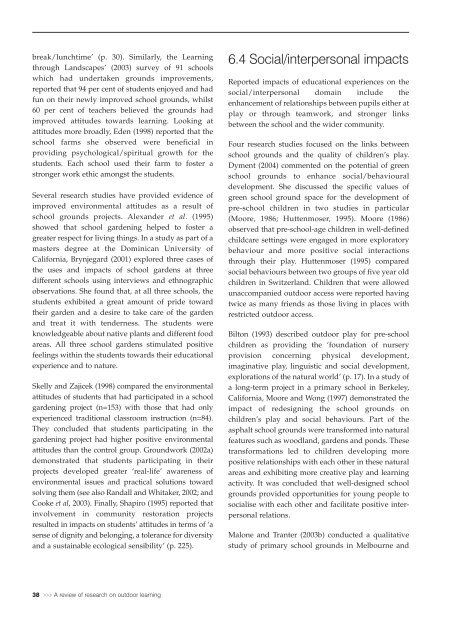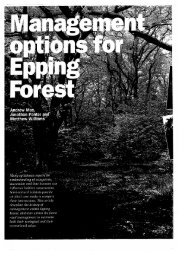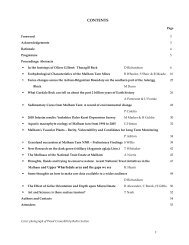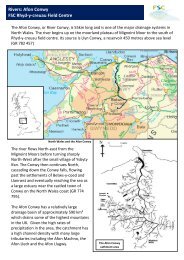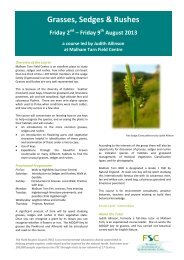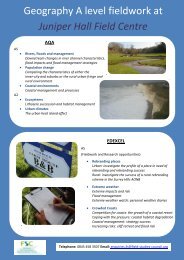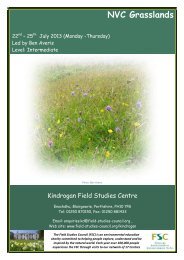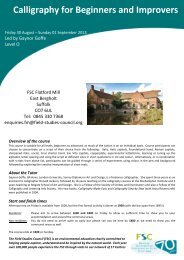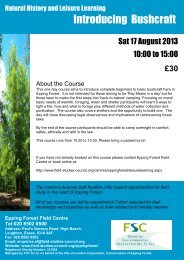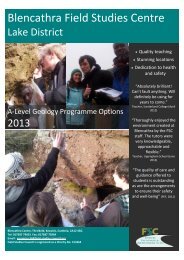A review of research on outdoor learning - Field Studies Council
A review of research on outdoor learning - Field Studies Council
A review of research on outdoor learning - Field Studies Council
- No tags were found...
You also want an ePaper? Increase the reach of your titles
YUMPU automatically turns print PDFs into web optimized ePapers that Google loves.
eak/lunchtime’ (p. 30). Similarly, the Learningthrough Landscapes’ (2003) survey <str<strong>on</strong>g>of</str<strong>on</strong>g> 91 schoolswhich had undertaken grounds improvements,reported that 94 per cent <str<strong>on</strong>g>of</str<strong>on</strong>g> students enjoyed and hadfun <strong>on</strong> their newly improved school grounds, whilst60 per cent <str<strong>on</strong>g>of</str<strong>on</strong>g> teachers believed the grounds hadimproved attitudes towards <strong>learning</strong>. Looking atattitudes more broadly, Eden (1998) reported that theschool farms she observed were beneficial inproviding psychological/spiritual growth for thestudents. Each school used their farm to foster astr<strong>on</strong>ger work ethic am<strong>on</strong>gst the students.Several <str<strong>on</strong>g>research</str<strong>on</strong>g> studies have provided evidence <str<strong>on</strong>g>of</str<strong>on</strong>g>improved envir<strong>on</strong>mental attitudes as a result <str<strong>on</strong>g>of</str<strong>on</strong>g>school grounds projects. Alexander et al. (1995)showed that school gardening helped to foster agreater respect for living things. In a study as part <str<strong>on</strong>g>of</str<strong>on</strong>g> amasters degree at the Dominican University <str<strong>on</strong>g>of</str<strong>on</strong>g>California, Brynjegard (2001) explored three cases <str<strong>on</strong>g>of</str<strong>on</strong>g>the uses and impacts <str<strong>on</strong>g>of</str<strong>on</strong>g> school gardens at threedifferent schools using interviews and ethnographicobservati<strong>on</strong>s. She found that, at all three schools, thestudents exhibited a great amount <str<strong>on</strong>g>of</str<strong>on</strong>g> pride towardtheir garden and a desire to take care <str<strong>on</strong>g>of</str<strong>on</strong>g> the gardenand treat it with tenderness. The students wereknowledgeable about native plants and different foodareas. All three school gardens stimulated positivefeelings within the students towards their educati<strong>on</strong>alexperience and to nature.Skelly and Zajicek (1998) compared the envir<strong>on</strong>mentalattitudes <str<strong>on</strong>g>of</str<strong>on</strong>g> students that had participated in a schoolgardening project (n=153) with those that had <strong>on</strong>lyexperienced traditi<strong>on</strong>al classroom instructi<strong>on</strong> (n=84).They c<strong>on</strong>cluded that students participating in thegardening project had higher positive envir<strong>on</strong>mentalattitudes than the c<strong>on</strong>trol group. Groundwork (2002a)dem<strong>on</strong>strated that students participating in theirprojects developed greater ‘real-life’ awareness <str<strong>on</strong>g>of</str<strong>on</strong>g>envir<strong>on</strong>mental issues and practical soluti<strong>on</strong>s towardsolving them (see also Randall and Whitaker, 2002; andCooke et al, 2003). Finally, Shapiro (1995) reported thatinvolvement in community restorati<strong>on</strong> projectsresulted in impacts <strong>on</strong> students’ attitudes in terms <str<strong>on</strong>g>of</str<strong>on</strong>g> ‘asense <str<strong>on</strong>g>of</str<strong>on</strong>g> dignity and bel<strong>on</strong>ging, a tolerance for diversityand a sustainable ecological sensibility’ (p. 225).6.4 Social/interpers<strong>on</strong>al impactsReported impacts <str<strong>on</strong>g>of</str<strong>on</strong>g> educati<strong>on</strong>al experiences <strong>on</strong> thesocial/interpers<strong>on</strong>al domain include theenhancement <str<strong>on</strong>g>of</str<strong>on</strong>g> relati<strong>on</strong>ships between pupils either atplay or through teamwork, and str<strong>on</strong>ger linksbetween the school and the wider community.Four <str<strong>on</strong>g>research</str<strong>on</strong>g> studies focused <strong>on</strong> the links betweenschool grounds and the quality <str<strong>on</strong>g>of</str<strong>on</strong>g> children’s play.Dyment (2004) commented <strong>on</strong> the potential <str<strong>on</strong>g>of</str<strong>on</strong>g> greenschool grounds to enhance social/behaviouraldevelopment. She discussed the specific values <str<strong>on</strong>g>of</str<strong>on</strong>g>green school ground space for the development <str<strong>on</strong>g>of</str<strong>on</strong>g>pre-school children in two studies in particular(Moore, 1986; Huttenmoser, 1995). Moore (1986)observed that pre-school-age children in well-definedchildcare settings were engaged in more exploratorybehaviour and more positive social interacti<strong>on</strong>sthrough their play. Huttenmoser (1995) comparedsocial behaviours between two groups <str<strong>on</strong>g>of</str<strong>on</strong>g> five year oldchildren in Switzerland. Children that were allowedunaccompanied <strong>outdoor</strong> access were reported havingtwice as many friends as those living in places withrestricted <strong>outdoor</strong> access.Bilt<strong>on</strong> (1993) described <strong>outdoor</strong> play for pre-schoolchildren as providing the ‘foundati<strong>on</strong> <str<strong>on</strong>g>of</str<strong>on</strong>g> nurseryprovisi<strong>on</strong> c<strong>on</strong>cerning physical development,imaginative play, linguistic and social development,explorati<strong>on</strong>s <str<strong>on</strong>g>of</str<strong>on</strong>g> the natural world’ (p. 17). In a study <str<strong>on</strong>g>of</str<strong>on</strong>g>a l<strong>on</strong>g-term project in a primary school in Berkeley,California, Moore and W<strong>on</strong>g (1997) dem<strong>on</strong>strated theimpact <str<strong>on</strong>g>of</str<strong>on</strong>g> redesigning the school grounds <strong>on</strong>children’s play and social behaviours. Part <str<strong>on</strong>g>of</str<strong>on</strong>g> theasphalt school grounds were transformed into naturalfeatures such as woodland, gardens and p<strong>on</strong>ds. Thesetransformati<strong>on</strong>s led to children developing morepositive relati<strong>on</strong>ships with each other in these naturalareas and exhibiting more creative play and <strong>learning</strong>activity. It was c<strong>on</strong>cluded that well-designed schoolgrounds provided opportunities for young people tosocialise with each other and facilitate positive interpers<strong>on</strong>alrelati<strong>on</strong>s.Mal<strong>on</strong>e and Tranter (2003b) c<strong>on</strong>ducted a qualitativestudy <str<strong>on</strong>g>of</str<strong>on</strong>g> primary school grounds in Melbourne and38 >>> A <str<strong>on</strong>g>review</str<strong>on</strong>g> <str<strong>on</strong>g>of</str<strong>on</strong>g> <str<strong>on</strong>g>research</str<strong>on</strong>g> <strong>on</strong> <strong>outdoor</strong> <strong>learning</strong>


